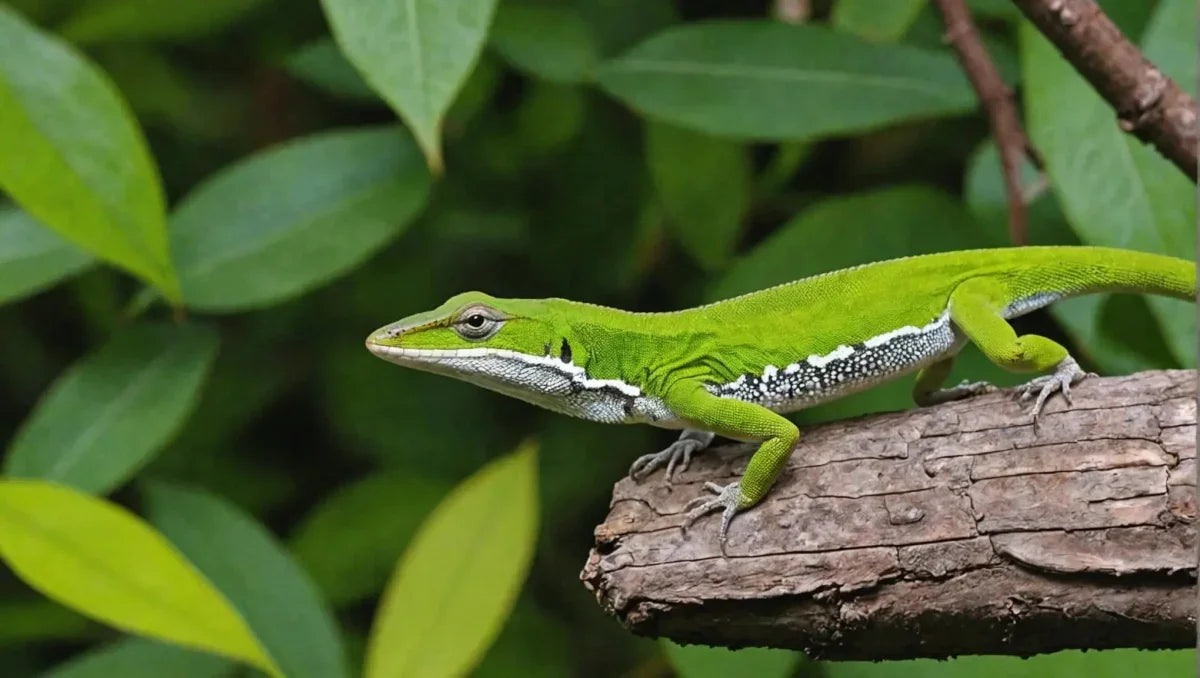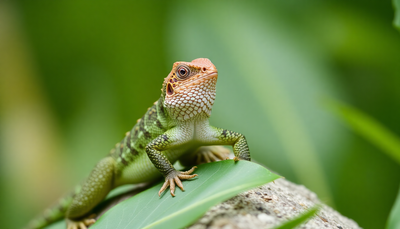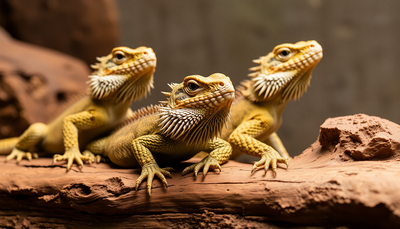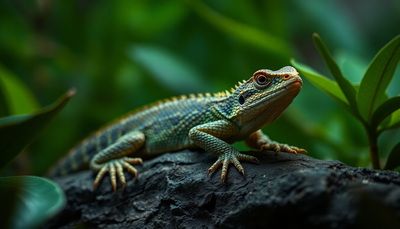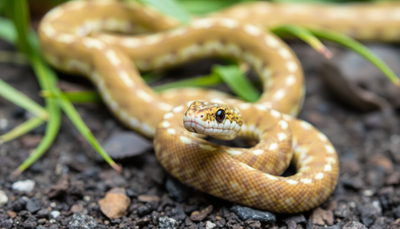Anole Lizard Diet: A Comprehensive Guide

Welcome to the comprehensive guide on the Anole Lizard diet, focusing on ensuring proper nutrition for these fascinating reptiles. Anoles are popular pets known for their vibrant colors and active behavior, making it essential to understand their dietary requirements. In this guide, we will delve into the specific nutritional needs of Anole Lizards, exploring the types of foods that are essential for their health and well-being. By following the recommendations outlined here, you will be able to provide your Anole Lizard with a balanced and healthy diet that promotes their growth and vitality. Whether you are a new Anole owner or looking to enhance your current feeding practices, this guide will equip you with the knowledge and insights needed to optimize your pet's nutrition. Join us on this educational journey into the world of Anole Lizard diet and discover how to best care for these remarkable creatures.
Anole Lizards: Exploring Their Dietary Habits
Anole lizards, scientifically classified as Anolis, are captivating reptiles known for their diverse and intriguing diet in the wild. Understanding what these remarkable creatures consume sheds light on their ecological role and survival strategies. Let's delve deeper into the dietary habits of Anole lizards, exploring their natural prey and the role of vegetation and fruits in their nutrition.
Natural Prey: Insects and Invertebrates
Anole lizards are skilled predators when it comes to hunting insects and invertebrates. Their diet primarily consists of a variety of small creatures found in their habitat. From nimble crickets to industrious ants, from colorful beetles to delicate spiders, Anole lizards use their keen eyesight and lightning-fast reflexes to capture these prey items. This hunting behavior not only sustains them but also highlights their adaptability to different prey types based on availability.
Vegetation and Fruits in their Diet
In addition to insects and invertebrates, Anole lizards incorporate vegetation and fruits into their diet. While these reptiles are predominantly carnivorous, they occasionally supplement their diet with plant matter. Anole lizards exhibit a preference for small fruits like berries, relishing the burst of flavor and nutrients these treats offer. Moreover, they may also nibble on tender plant parts such as flower petals and leaves, showcasing a diverse palate that complements their predatory instincts.
Nutritional Adaptations and Ecological Significance
The varied diet of Anole lizards plays a crucial role in providing them with essential nutrients for growth, reproduction, and overall well-being. By consuming a mix of protein-rich insects, fiber-laden plant material, and nutrient-dense fruits, these lizards maintain a balanced diet that supports their energetic lifestyle. Furthermore, their dietary habits contribute to ecosystem dynamics by regulating insect populations and dispersing seeds through their fruit consumption, showcasing their significance in the web of life.
Dietary Preferences and Behavioral Adaptations
Apart from their diet composition, Anole lizards also exhibit interesting dietary preferences and behavioral adaptations. Research indicates that certain species of Anolis may show selectivity towards specific insect species, suggesting a level of dietary specialization within the genus. This specialization could be influenced by factors such as prey availability, seasonal variations, and habitat characteristics, showcasing the intricate relationship between diet and environmental factors in shaping the feeding behavior of Anole lizards.
Foraging Strategies and Feeding Techniques
Anole lizards employ diverse foraging strategies and feeding techniques to acquire and consume their food. Their ability to detect prey movement, employ stealth tactics, and execute precise strikes enables them to effectively capture insects and invertebrates. Additionally, their utilization of vegetation for both nutrition and camouflage further underscores their resourcefulness in the wild. By blending efficient hunting techniques with selective feeding behaviors, Anole lizards showcase a multifaceted approach to meeting their dietary needs while navigating the challenges of their natural habitat.
The dietary habits of Anole lizards reflect their adaptability and resilience in the wild. By embracing a diverse menu that includes insects, invertebrates, vegetation, and fruits, these reptiles exemplify the art of survival through nutritional versatility, behavioral adaptations, and ecological interconnectedness.
Essential Nutrients for Anole Lizards
Role of Calcium and Vitamin D3
Anole lizards require adequate levels of calcium and vitamin D3 for proper bone development and overall health. Calcium is essential for bone strength, muscle function, and nerve transmission, while vitamin D3 helps in the absorption of calcium from the diet. It is crucial to provide a balanced diet rich in calcium and ensure exposure to UVB light for vitamin D3 synthesis.
Importance of Protein and Fiber
Protein is essential for growth, tissue repair, and overall metabolic functions in anole lizards. Including protein sources such as insects, worms, and small vertebrates in their diet is crucial. Fiber, on the other hand, aids in digestion and helps prevent constipation. Vegetables and fruits can be good sources of fiber for anoles.
Ensuring Proper Hydration
Maintaining proper hydration is vital for the health of anole lizards. These reptiles may not always actively seek out water, so it is important to provide a shallow water dish for them to drink from. Additionally, regular misting of the enclosure can help maintain humidity levels and provide opportunities for lizards to drink water droplets. Monitoring hydration levels is crucial to prevent dehydration and related health issues in anoles.
Vitamin and Mineral Supplements
In addition to a well-rounded diet, anole lizards may benefit from vitamin and mineral supplements. These supplements can help fill any nutritional gaps and ensure that the lizards are receiving all the essential nutrients they need for optimal health. However, it is important to consult with a veterinarian specializing in reptiles to determine the correct dosage and type of supplements suitable for anoles.
Gut Loading Prey Items
When feeding insects or other live prey to anole lizards, it is essential to practice gut loading. Gut loading involves feeding the prey items a nutritious diet before offering them to the lizards. This ensures that the prey items are packed with essential nutrients, which are then passed on to the lizards upon consumption. Gut loading can significantly enhance the nutritional value of the prey items and contribute to the overall health of anole lizards.
Monitoring and Adjusting Diet
As the dietary needs of anole lizards may vary based on factors such as age, activity level, and overall health, it is crucial to monitor their dietary intake regularly. Observing the lizards' behavior, growth rate, and overall health can provide valuable insights into whether their nutritional needs are being met adequately. If any signs of nutritional deficiencies or imbalances are observed, adjustments to the diet should be made promptly to ensure the lizards' well-being.
Seeking Professional Guidance
For novice reptile owners or those facing challenges in meeting the dietary requirements of anole lizards, seeking professional guidance from a reptile veterinarian or experienced herpetologist is highly recommended. These experts can offer personalized advice on designing a suitable diet plan, selecting the right supplements, and addressing any specific nutritional concerns related to anole lizards. By seeking professional guidance, reptile owners can ensure that their anole lizards receive the best possible care and nutrition to thrive in captivity.
Feeding Practices for Anole Lizards
Anole lizards, known for their vibrant colors and active nature, are popular pets among reptile enthusiasts. Proper feeding practices are essential to ensure the health and well-being of these fascinating creatures. In this section, we will discuss key aspects of feeding practices for Anole lizards.
Frequency and Portion Control
Maintaining the right feeding schedule is crucial for Anole lizards. Offer food items such as small insects (crickets, mealworms, dubia roaches) every 1-2 days for adult Anoles. Juveniles may require daily feeding to support their growth. Avoid overfeeding, as obesity can lead to various health issues. It's also important to provide a varied diet to ensure they receive all necessary nutrients.
Recommended Food Choices
Anole lizards are insectivores, meaning their diet primarily consists of insects. In addition to crickets, mealworms, and dubia roaches, you can also include small grasshoppers, waxworms, and fruit flies in their diet. Gut-loading insects with nutritious foods before offering them to Anoles ensures they receive essential nutrients. Consider dusting insects with calcium and vitamin supplements to prevent nutritional deficiencies.
Identifying and Avoiding Toxic Foods
Certain foods can be toxic to Anole lizards and should be avoided. Avoid feeding them fireflies, as they contain toxins that can harm Anoles. Additionally, steer clear of toxic plants such as ivy, azaleas, and daffodils, as they can be harmful if ingested. Always research food items before offering them to your Anole to prevent any potential health issues. Provide a safe and clean environment for your Anole to minimize the risk of exposure to harmful substances.
Monitoring Health and Behavior
Regularly monitor your Anole lizard's health and behavior. Look for signs of malnutrition, such as weight loss or lethargy, which may indicate a dietary deficiency. Ensure proper lighting and temperature in their habitat to support their overall well-being. Consult a veterinarian experienced with reptiles if you notice any concerning symptoms.
By following these comprehensive feeding practices, you can help ensure that your Anole lizard remains healthy and active. Remember to provide fresh water daily, maintain a clean habitat, and interact with your pet to build a strong bond. With proper care and attention, your Anole lizard can thrive in captivity and bring joy to your reptile-keeping experience.
Hydration Guidelines
Importance of Hydration for Anole Lizards
Anole lizards, like all living organisms, require proper hydration to maintain their health and well-being. Water is essential for various physiological functions such as temperature regulation, digestion, and waste elimination. Without adequate hydration, anole lizards can suffer from dehydration, which can lead to serious health issues. Dehydration in anole lizards can manifest in symptoms like sunken eyes, lethargy, wrinkled skin, and loss of appetite. It is crucial for their overall health and longevity that they have access to clean water at all times.
Methods to Maintain Adequate Hydration
-
Provide a Water Dish: One of the simplest ways to ensure that anole lizards stay hydrated is by providing a shallow water dish in their enclosure. Ensure that the water dish is shallow enough for easy access but deep enough for the lizard to submerge if needed. Clean and refill the water dish regularly to prevent the growth of harmful bacteria and algae.
-
Misting: Anoles can absorb water through their skin, so regularly misting their enclosure will create a humid environment, allowing them to drink water droplets from surfaces. Misting also helps maintain the humidity levels in the enclosure, benefiting the lizard's respiratory health.
-
Hydrating Foods: In addition to water, some fruits and vegetables have high water content and can help supplement your anole lizard's hydration. Offer foods like cucumbers, melons, strawberries, and leafy greens to increase their water intake. These foods not only provide hydration but also offer essential nutrients for overall health.
-
Soaking: If you suspect that your anole lizard is dehydrated, you can gently soak them in a shallow container of lukewarm water. Supervise the soaking session closely to prevent any accidents and ensure that the water is not too hot or too cold. This method can help rehydrate the lizard through their skin and aid in restoring their hydration levels.
-
Monitoring and Veterinary Care: Regularly monitor your anole lizard's hydration status by observing their behavior and physical appearance. If you notice any signs of dehydration or health issues, consult a reptile veterinarian for proper diagnosis and treatment. Professional guidance can help address underlying health issues affecting your lizard's hydration levels.
Remember, maintaining proper hydration is essential for the well-being of anole lizards. By implementing these hydration guidelines and providing a suitable environment, you can promote the health, vitality, and happiness of your pet lizard.
Conclusion
Ensuring that your anole lizard receives a proper diet is essential for their health and well-being. By providing a balanced and nutritious diet consisting of insects, fruits, and vegetables, you can help your anole thrive in captivity. Remember to offer variety, monitor their eating habits, and make adjustments as needed to promote a long and healthy life for your beloved pet. By following these guidelines, you can be confident that you are meeting your anole's nutritional needs and promoting their overall wellness.


